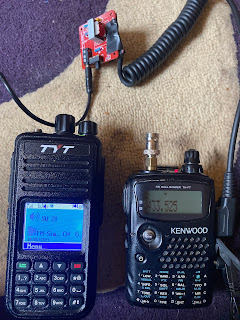A post where I can finally meld electronics and radio and make something useful, hooray!
I've been tinkering for a while on a simple audio interface for connecting up to my handheld radio. Essentially this means I can use the computer as a microphone source, or send tones for data modes like RTTY and SSTV instead of just voice. The only issue is that experimenting with things means building shitty bits of stripboard and wire links, burnt fingers and a lot of frustration: no thank you. So after finally managing to bodge one together that worked I immediately started working on an upgrade to a PCB version that wasn't stuffed into a toothbrush case.
The original source for the circuit is here: https://k0rx.com/blog/2017/11/baofeng.html (David Andersen, K0RX) and it works really well. I had to experiment with resistor values as David says on his website, but eventually I got something working in a prototype form that gave great audio in and out and have used this to do some SSTV Summits on the Air activations. David was also nice enough to clear up some questions about the grounds via email, as some of them need to be kept separate (the RS232, mostly).
Transferring his very simple design into KiCad was quite easy, although I wanted a proper 3D preview of things so I had to find some models to import into the software. I also had to make a few new footprints AND design a 3D model from scratch in FreeCAD for the 1:1 audio transformer used in the circuit. But after a few weeks the PCB fairy came from China and delivered 5 new boards through my door. I went for red boards this time, and it looks great. It's about 4cm on each side. I immediately started tearing apart my working prototype rather than buy new parts to make one up (some would say a bad call) and thankfully it all worked first time, minus the optocoupler bit as I don't have a USB to RS232 interface yet. So instead there's a slide switch to change between Tx and Rx. I've chosen a TRRS socket as you can see to work with modern laptops, although it'd be good to find a solution to connect it to a tablet for the ultimate in lightweight portable data mode operating. You could also break it out into 2 X TRS for separate mic/output sockets if required. The 2 pin cable came from a Baofeng mic I cut the actual mic off, but hopefully I can find a place to order the cables with bare ends? I have no kit to make my own up, sadly. It ended up working first time to the exact same specifications as the prototype and I'm really impressed with how it came out. As always I used JLCPCB for my fabbing and they always make great boards for what I need. Next time I make one of these I'll try and put a better connector on the radio cable side though. Right now I just have bare solder pads and it's a big weak point. A box would help, obviously. Turns out Tic Tacs boxes are about the right size... Skip to main content
Skip to main content






Hi Mark,
ReplyDeletevery interesting, are you flogging these?
Paul 2M0ILA
Hey Paul! Missed this one. I thought about it but there are much better ones available. I have some spare if you’d like a kit though?
Delete